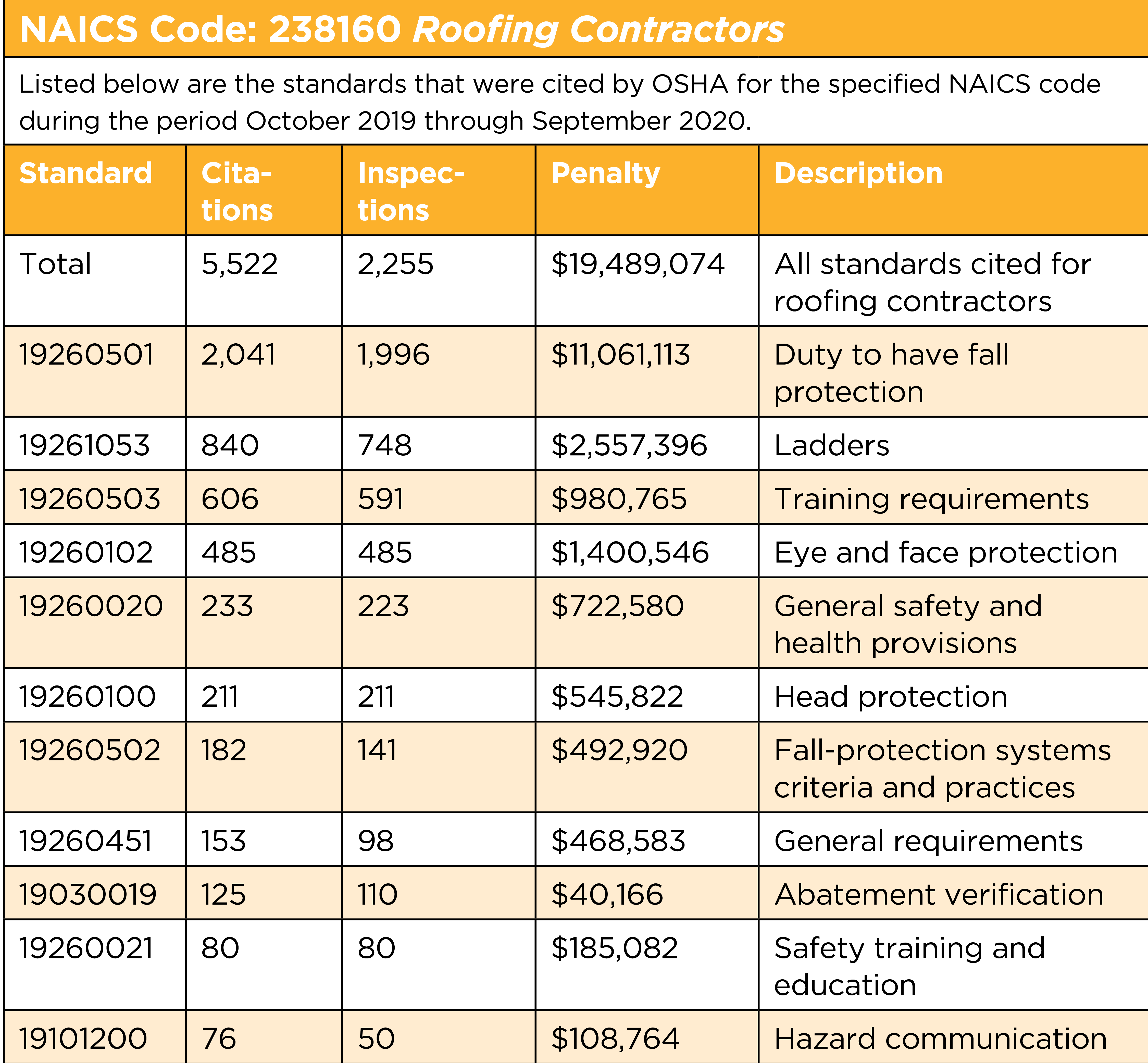As a roofing contractor, you know all too well the dangers of roofing work. And you also know there are proven ways to reduce fall-related injuries and deaths. Yet recently released numbers from the Bureau of Labor Statistics for 2019 show 1,102 fatal worker injuries in construction of which 418 were from falls. From that same data, total roofing worker fatalities were 111 with 93 resulting from falls. These numbers show falls continue to be the leading cause of death for the construction industry.
Fall deaths from roofing workers account for about 20% of construction deaths and a whopping 84% of roofing industry deaths. As a result, it is a foregone conclusion that roofing contractors will continue to be the target of scrutiny by the Occupational Safety and Health Administration and oversight by the insurance industry.
Citations
During 2020, the roofing industry was cited for almost $20 million in OSHA penalties. Of that figure, close to $13 million, or 65%, was related to fall protection.

Topping the list of citations is OSHA’s 29 CFR§1926.501 standard, which is the duty to have fall protection. It is a relatively straightforward standard that says: “Each employee on a walking/working surface (horizontal and vertical surface) with an unprotected side or edge which is 6 feet (1.8 m) or more above a lower level shall be protected from falling by the use of guardrail systems, safety net systems, or personal fall-arrest systems.”
In other words, providing some means of fall protection anytime there is the potential of falling 6 feet or more is mandatory. According to the data, this is not happening in the field. The question is: “Why?”
During a recent NRCA Health & Safety Committee meeting, Aaron Kock, vice president of CNA Insurance Cos., Chicago, reported an increase in the number of fall-through-related claims in the NRCA-sponsored CNA Insurance program.
Kock explained: “As we looked at what caused these claims, a few trends emerged. A major driver was the lack of coordination between subcontractors and prime contractors especially as it relates to covering roof openings. We also saw cases of unprotected skylights and lack of follow-up when compromised decking was found.”
New tools
As fall-related injuries and deaths continue to grow, the roofing industry has responded by developing new tools to train and educate workers exposed to falls. NRCA recently made available an easy-to-use job hazard analysis template intended to help you identify anticipated and potential hazards encountered during a project. The template also prompts procedures and methods for controlling the safety hazards identified.
The fundamental principles behind a job hazard analysis are to identify hazards, focus training needs, and supply proper equipment and materials to prevent accidents from occurring. NRCA’s template is organized by topic areas. Because each job is unique, not all the sections will necessarily be used, and you may need to supplement it for unique hazards associated with a particular project.
Importantly, a job hazard analysis is a living document, and as such, it must be updated as a job progresses because issues can arise at any time during a project’s life. Making sure your workforce is continually trained and supplied with appropriate tools to address evolving issues is key to reducing and eliminating accidents.
Progress
Those in the construction industry have long recognized the sad statistics of fall-related injuries and fatalities and the vital need to work harder to reduce and eliminate them. Safety professionals are developing real-world solutions to assist the needs of contractors looking for answers. For example, nonpenetrating systems, mobile systems, prefabricated skylight hole coverings and leading-edge retractable devices have become popular choices for contractors.
NRCA and other construction industry organizations have recognized the severity of the issue and participate in OSHA’s annual National Safety Stand Down to prevent falls in construction. This year’s event took place May 3-7. The voluntary event encourages and supports employers to talk directly to employees about fall-prevention safety. Workplaces hold a “stand down” by taking a formal break from work to focus on fall hazards and reinforce the importance of fall prevention.
Employees are encouraged to share their perspectives with management about fall-related concerns and questions. It’s also a great opportunity to identify other job hazards they see needing attention.
Once again, NRCA offered three 30-minute free training sessions about fall-related issues during the stand-down week. The first session focused on fall-protection systems (guardrails, warning lines and safety monitors) and ladder setup. The second session addressed the use of personal fall-arrest systems and discussed how to properly calculate clearance distances. And the third session targeted self-rescue techniques, including how to relieve suspension trauma. It is through continuous efforts like OSHA’s National Safety Stand Down and the efforts of individual companies that make the difference. A well-trained workforce is the key to preventing falls in the future.
Rich Trewyn is an NRCA director of enterprise risk management.



